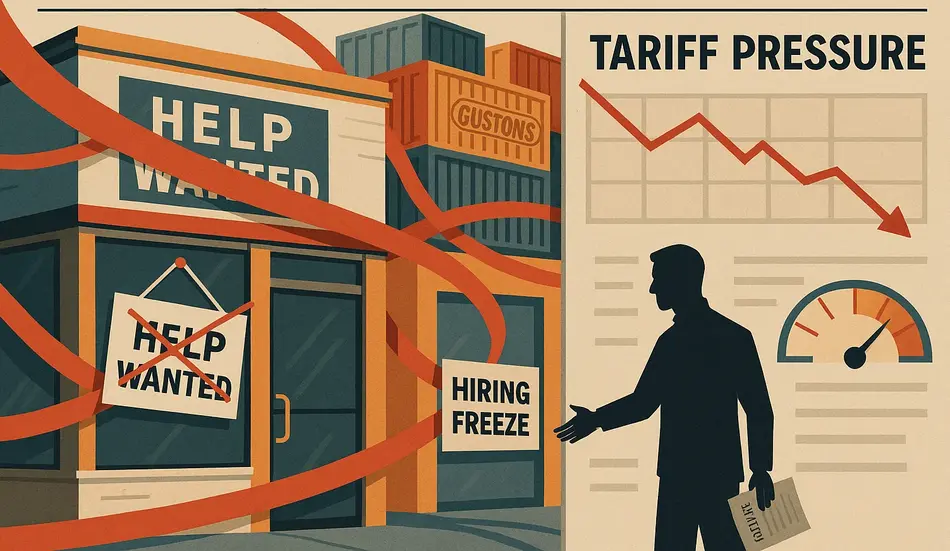Key takeaways
- The ISM Services PMI slipped to 50.1 in July—just above the growth/contraction line—while the employment sub-index fell to 46.4 (contraction) and prices jumped to 69.9, the highest since Oct. 2022, signaling sticky cost pressures.
- New export orders and imports turned negative, and ISM respondents said tariff impacts were the most common topic in July’s survey.
- U.S. payrolls rose by just +73,000 in July, with large downward revisions (-258,000) to May and June; hiring continued in health care and social assistance, while professional & business services and federal government shed jobs.
- Tariff policy tightened this summer through new executive actions and extended Section 301 exclusions (now through Aug. 31, 2025), adding complexity for import-reliant services.
- A separate gauge, the S&P Global US Services PMI, rose to 55.7, showing stronger private-survey momentum—but business confidence weakened on tariff uncertainty.
What the latest data says
The services side of the U.S. economy—everything from logistics and finance to health care and hospitality—barely expanded in July. The Institute for Supply Management’s headline Services PMI registered 50.1, down from 50.8 in June; that’s technically growth, but only just. Under the hood, two details matter most for hiring managers:
- Employment contracted: The ISM employment index dropped to 46.4, marking contraction in four of the last five months.
- Prices re-accelerated: The prices index surged to 69.9, its highest reading since late 2022 and the eighth straight month above 60, indicating broad-based cost increases.
ISM also flagged softening new orders (50.3) and a deterioration in external demand: both new export orders (47.9) and imports (45.9) slipped into contraction. Survey commentary repeatedly referenced tariff-related impacts, including postponed projects and inventory moves to get ahead of tariff changes.
This mix—weak hiring, higher prices, and tariff uncertainty—is exactly the kind of “stagflation-lite” profile that has begun to worry markets. Recent coverage highlighted the combination of rising services prices and fragile growth as a key macro theme.
Hiring: where it slowed—and where it didn’t
The official jobs report for July shows the same cooling trend. Nonfarm payrolls rose by just +73,000, and earlier months were revised down a steep -258,000, a sign the labor market has less momentum than previously thought.
Within services:
- Health care (+55,000) led gains, especially ambulatory health care (+34,000) and hospitals (+16,000). Social assistance continued to trend up (+18,000).
- Professional & business services fell (-14,000); within that, business support services continued to decline (-6,000), and temporary help—often a leading indicator—was down another 4,000 and is -655,000 since its March 2022 peak.
- Retail changed little (+16,000); transportation & warehousing rose modestly (+4,000). Federal government employment continued to fall (-12,000).
On the ISM industry list, accommodation & food services and professional, scientific & technical services were among the categories reporting contraction in July, suggesting caution in discretionary services and white-collar demand alike.
Is Your Business Struggling to Hire Under Tariff Pressure?
Don’t let trade headwinds slow your growth—reach top talent faster with WhatJobs.
Post a Job Now →Tariffs are back at center stage for services
Why do tariffs matter for services? Many service firms are import-dependent—think: retailers and wholesalers, health-care providers buying equipment, logistics firms handling cross-border shipments, IT and data-center operators procuring hardware, and construction/maintenance vendors sourcing materials. When tariffs change, input costs and delivery times move, which can delay projects, crimp margins, and slow hiring. ISM respondents explicitly noted that tariff-driven cost increases were forcing project postponements and that “extra purchasing to head off tariffs” was fading heading into the second half.
Policy-wise, 2025 has brought new executive actions modifying reciprocal tariff rates, alongside Section 232/IEEPA moves and extensions of Section 301 exclusions that add nuance product-by-product. The USTR extended a slate of China tariff exclusions through Aug. 31, which helps certain importers temporarily, but the broader tariff regime remains tighter than a year ago. A CBP factsheet summarizes this year’s changes and authorities used.
The evolving policy landscape is already showing up in ISM sub-indices: both imports and new export orders slid into contraction in July, and the supplier deliveries index (which is inverted) indicates slower deliveries—consistent with renewed congestion and precautionary ordering.
Prices flare again: the risk to margin planning
Services inflation is notoriously sticky, and July’s ISM prices index at 69.9 underscores the challenge. Higher costs for software licensing, steel products, aluminum, MRO supplies, and transportation were among the items cited as “up in price.” When prices run hot while hiring cools, margin planning gets tougher and employers tend to delay backfills or become more selective about new roles.
Market strategists have increasingly framed this as a stagflation-risk environment: slowing growth + firm inflation, with tariffs among the shocks complicating the outlook
Why one survey looks strong while another looks soggy
If you follow multiple indicators, you noticed a split: S&P Global’s U.S. Services PMI showed a solid July acceleration to 55.7, the best of 2025 so far. Meanwhile, ISM hovered near stall speed at 50.1. What gives? The two surveys sample different firm sets and ask different questions, so short-term divergences are common. S&P’s July commentary tied strength to domestic demand, even as confidence slipped on policy concerns such as tariffs and federal spending cuts—consistent with the anxiety captured by ISM’s tariff-heavy respondent quotes.
The takeaway for operators: momentum hasn’t collapsed, but hiring appetite is softer, and price/cost visibility is worse than a few months ago.
Sectors feeling the pinch first
- Trade, Transportation & Warehousing. Logistics firms and wholesalers face higher landed costs and slower supplier deliveries, which can tighten working capital and pressure staffing in network ops and customer support. ISM’s Supplier Deliveries moved higher (slower), and Transportation & Warehousing was among industries reporting slower deliveries.
- Professional & Business Services. BLS shows continued weakness, particularly in business support and temp help—roles employers scale back first when margins compress.
- Accommodation & Food Services. This category reported contraction in ISM; tariffs and higher input costs (from kitchen equipment to packaged foods) feed through quickly in this margin-thin sector.
- Health Care & Social Assistance. A notable exception: BLS shows robust hiring, yet ISM respondents within health care flagged tariff-driven equipment and supply costs as a reason they’re postponing other projects—a potential brake if price pressure persists.
What to watch next
- Tariff calendar & exclusions. Watch the Aug. 31 deadline for current Section 301 exclusions and any additional executive actions that adjust reciprocal rates or country lists. Industry groups have circulated schedules showing date-specific adjustments and delays through late July. If exclusions lapse, costs could ratchet higher in September.
- Next ISM release. ISM’s August services data arrives Sept. 4; a sustained sub-50 employment reading would strengthen the case that services hiring is rolling over into autumn.
- Official jobs data. After large downward revisions, business planners should re-benchmark headcount assumptions against the next Employment Situation report to avoid over-hiring to outdated run-rates.
What it means if you’re hiring (or job hunting)
- Budget owners: Build 5–10% price contingencies into Q4 services procurement and capital projects exposed to imported hardware, fixtures, or consumables. Stagger hiring for roles directly tied to tariff-sensitive programs (e.g., store build-outs, data-center equipment rollouts) until clarity on exclusion renewals.
- HR & TA teams: Expect longer approvals and deeper ROI scrutiny on backfills. Consider contract-to-perm to manage uncertainty; keep pipelines warm in health care and social assistance, where demand is proving durable.
- Job seekers: Look for counter-cyclical niches—care delivery, social services, compliance, and roles helping firms re-route supply chains (trade compliance, logistics optimization). Certifications that touch customs, tariff classification, and vendor compliance will stand out in today’s postings.
The bottom line
The services engine hasn’t stalled out—but it’s sputtering. July’s data portray an economy still expanding, yet hiring is tightening and costs are flaring. With tariffs now the No. 1 recurring theme in ISM’s respondent commentary—and import/export gauges slipping—executives are pausing discretionary projects and getting more cautious on headcount. If upcoming policy decisions raise effective duty rates or allow exclusions to expire, pressure could intensify into September. Conversely, any stabilization on trade policy could quickly unlock delayed projects and restore hiring appetite, particularly in tariff-exposed service verticals.
FAQs
Why do tariffs hit services, not just manufacturers?
Many service firms buy imported equipment, hardware, and supplies or rely on global logistics. Tariffs raise input costs and can delay deliveries, squeezing margins and slowing hiring. July’s ISM showed slower deliveries and tariff-driven cost concerns across multiple service industries.
Why are ISM and S&P Global telling different stories?
Which service categories are still hiring?
Health care and social assistance remain bright spots (+73k combined in July), while temp help and business support stayed soft.




